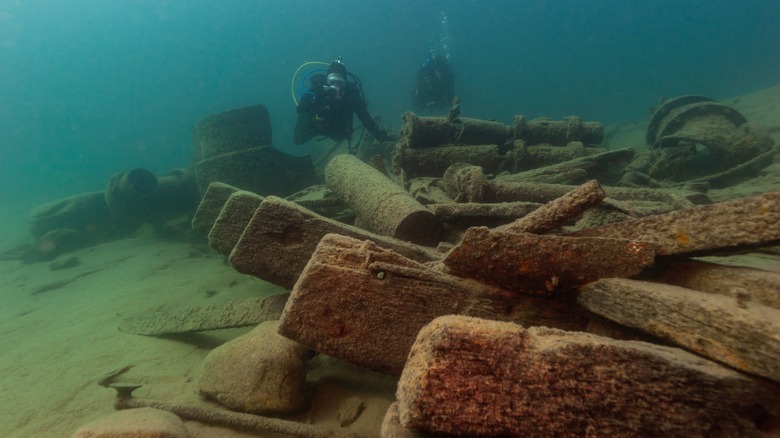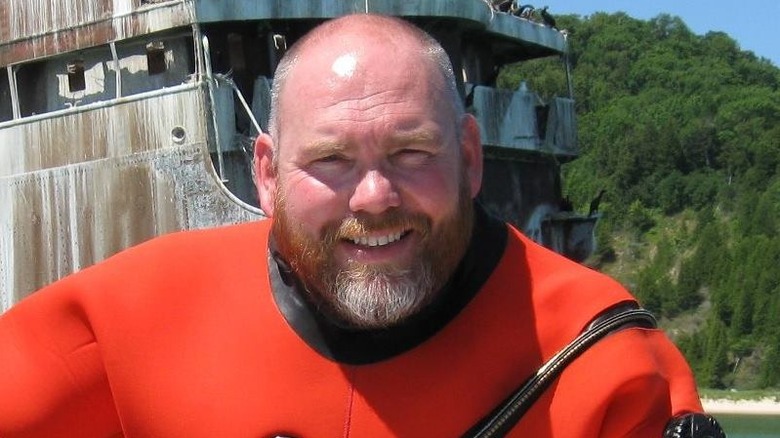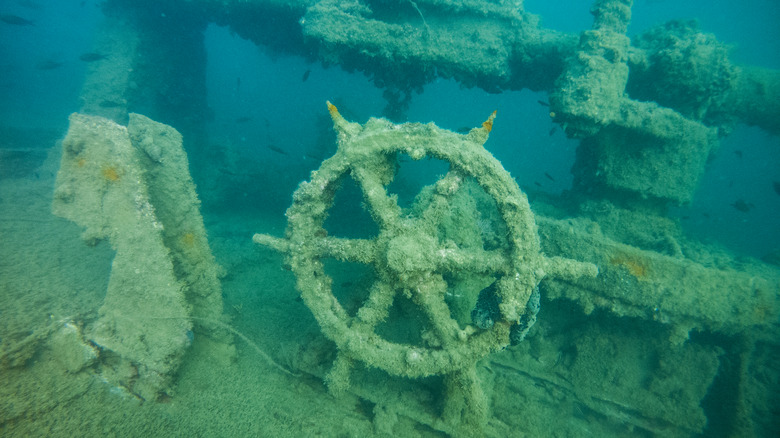The Distillers That Are Using Wood From Shipwrecks To Make Whiskey
When you think of aging whiskey, you probably think of amber liquid resting in oak barrels. The oak infuses the whiskey with toasty vanilla and caramel notes. French oak is used for a milder flavor, American oak for a bigger impact, and a combination barrel is used to create a happy medium. Without oak, whiskey wouldn't have the signature warm depth of flavor you need for your proper Manhattan or smoked old fashioned. But barreling isn't the only option for aging and infusing the liquor with those notes.
With the rise in distilleries, wineries, and breweries vying for barrels and coopers (barrel makers) becoming a more niche profession, oak barrels are becoming scarcer than before. Where regulations allow, some of these distillers, brewers, and wineries have turned to aging their liquids in stainless steel and dropping oak staves into the tanks to imbue those desired notes.
Normally, these oak staves are produced specifically for this exact use case. But Mammoth Distilling wants to gather its staves from somewhere very unusual: a shipwreck in Lake Michigan.
Experiencing history through unique booze
Mammoth Distilling is already known for dredging up history to make local Michigan whiskey. In 2020, distillery CEO and co-founder Chad Munger resurrected a heritage grain called Rosen rye on South Manitou Island, where it grew exclusively for 30 years before being lost to agricultural history for 70 years. Farming the grain on the island was no walk in the park: South Manitou is reachable only by an often treacherous 10-mile boat ride through the rough waters of the Manitou Passage, navigating around many shipwrecks.
One of those shipwrecks is the Westmoreland, one of the first 200-foot steam-powered propeller ships. It sank due to a leak during a snowstorm on December 7, 1854, six years before the Civil War, taking 15 lives and (supposedly) barrels of liquor and gold coins 200 feet below the surface of Lake Michigan. In 2010, wreck diver and researcher Ross Richardson found it.
A partnership between distillers and a diver
Ross Richardson has worked with Mammoth Distilling before. In 2019, they began a project salvaging old-growth wood from barns and old cabins together and have already implemented the use of shipwreck wood from a different wreck, gathered legally from another of the Great Lakes.
If there is whiskey in the Westmoreland, Mammoth would love to study it. Chad Munger isn't looking to bottle it, he told mLive, but by sampling it he and head distiller Ari Sussman may be able to understand and recreate it. Sussman wants to salvage pieces of oak that have (preferably) already fallen off the wreck, toast them, and use them as staves for whiskey. As the ship was headed to South Manitou for safe harbor, it's easy to imagine that Sussman and Munger will use their Rosen rye to tie the projects together. Richardson sees it as an opportunity for a thorough study and preservation of the wreck.
Controversy and conservation challenges
The Great Lakes states take great pride in the somber history of their bustling shipping industry at the bottom of their cold, freshwater inland seas. With the often ferocious weather of the northern Midwest, the lakes have claimed an estimated 6,000 ships and 30,000 lives to wrecks. Many of the wrecks are preserved as gravesites.
The 1987 Abandoned Shipwrecks Act was passed to protect sites in America's rivers, lakes, and up to 3 miles off the coast from scavenging wreck divers. The law makes it clear that the Westmoreland wreck belongs to and is managed by the Michigan state government and, though it is considered a recreational and educational opportunity, it's also a habitat for marine life, according to the National Parks Service.
Ross Richardson has a different opinion than current conservation practice, which would leave the wrecks untouched. Because climate change is warming the lake and invasive mussels are affecting the ecology of the systems that naturally slow decomposition, Richardson argues that the deterioration of these wrecks is accelerating to the point where the conservation standards could stand to be re-evaluated.
In an effort to protect the wreck from the disruption of tourism before more research and study can be done on the site, Richardson hasn't yet disclosed the coordinates but has started a nonprofit called Save the Westmoreland. If they can get the special permits required, Mammoth hopes to put proceeds from whiskey flavored by the wreck of the Westmoreland toward its preservation efforts.



